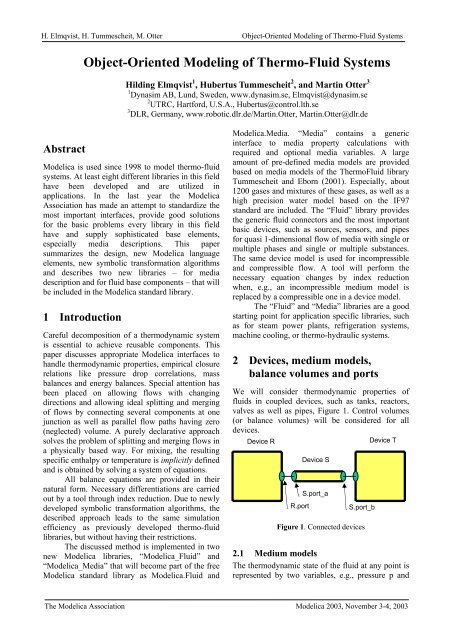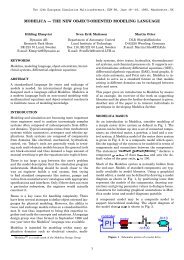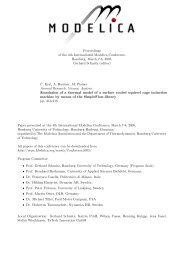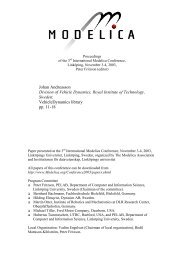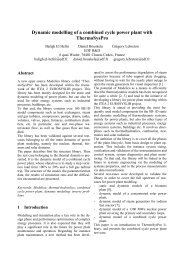Hilding Elmqvist, Hubertus Tummescheit and Martin Otter ... - Modelica
Hilding Elmqvist, Hubertus Tummescheit and Martin Otter ... - Modelica
Hilding Elmqvist, Hubertus Tummescheit and Martin Otter ... - Modelica
You also want an ePaper? Increase the reach of your titles
YUMPU automatically turns print PDFs into web optimized ePapers that Google loves.
H. <strong>Elmqvist</strong>, H. <strong>Tummescheit</strong>, M. <strong>Otter</strong> Object-Oriented Modeling of Thermo-Fluid Systems<br />
Abstract<br />
Object-Oriented Modeling of Thermo-Fluid Systems<br />
<strong>Hilding</strong> <strong>Elmqvist</strong> 1 , <strong>Hubertus</strong> <strong>Tummescheit</strong> 2 , <strong>and</strong> <strong>Martin</strong> <strong>Otter</strong> 3<br />
1 Dynasim AB, Lund, Sweden, www.dynasim.se, <strong>Elmqvist</strong>@dynasim.se<br />
2 UTRC, Hartford, U.S.A., <strong>Hubertus</strong>@control.lth.se<br />
3 DLR, Germany, www.robotic.dlr.de/<strong>Martin</strong>.<strong>Otter</strong>, <strong>Martin</strong>.<strong>Otter</strong>@dlr.de<br />
<strong>Modelica</strong> is used since 1998 to model thermo-fluid<br />
systems. At least eight different libraries in this field<br />
have been developed <strong>and</strong> are utilized in<br />
applications. In the last year the <strong>Modelica</strong><br />
Association has made an attempt to st<strong>and</strong>ardize the<br />
most important interfaces, provide good solutions<br />
for the basic problems every library in this field<br />
have <strong>and</strong> supply sophisticated base elements,<br />
especially media descriptions. This paper<br />
summarizes the design, new <strong>Modelica</strong> language<br />
elements, new symbolic transformation algorithms<br />
<strong>and</strong> describes two new libraries – for media<br />
description <strong>and</strong> for fluid base components – that will<br />
be included in the <strong>Modelica</strong> st<strong>and</strong>ard library.<br />
1 Introduction<br />
Careful decomposition of a thermodynamic system<br />
is essential to achieve reusable components. This<br />
paper discusses appropriate <strong>Modelica</strong> interfaces to<br />
h<strong>and</strong>le thermodynamic properties, empirical closure<br />
relations like pressure drop correlations, mass<br />
balances <strong>and</strong> energy balances. Special attention has<br />
been placed on allowing flows with changing<br />
directions <strong>and</strong> allowing ideal splitting <strong>and</strong> merging<br />
of flows by connecting several components at one<br />
junction as well as parallel flow paths having zero<br />
(neglected) volume. A purely declarative approach<br />
solves the problem of splitting <strong>and</strong> merging flows in<br />
a physically based way. For mixing, the resulting<br />
specific enthalpy or temperature is implicitly defined<br />
<strong>and</strong> is obtained by solving a system of equations.<br />
All balance equations are provided in their<br />
natural form. Necessary differentiations are carried<br />
out by a tool through index reduction. Due to newly<br />
developed symbolic transformation algorithms, the<br />
described approach leads to the same simulation<br />
efficiency as previously developed thermo-fluid<br />
libraries, but without having their restrictions.<br />
The discussed method is implemented in two<br />
new <strong>Modelica</strong> libraries, “<strong>Modelica</strong>_Fluid” <strong>and</strong><br />
“<strong>Modelica</strong>_Media” that will become part of the free<br />
<strong>Modelica</strong> st<strong>and</strong>ard library as <strong>Modelica</strong>.Fluid <strong>and</strong><br />
<strong>Modelica</strong>.Media. “Media” contains a generic<br />
interface to media property calculations with<br />
required <strong>and</strong> optional media variables. A large<br />
amount of pre-defined media models are provided<br />
based on media models of the ThermoFluid library<br />
<strong>Tummescheit</strong> <strong>and</strong> Eborn (2001). Especially, about<br />
1200 gases <strong>and</strong> mixtures of these gases, as well as a<br />
high precision water model based on the IF97<br />
st<strong>and</strong>ard are included. The “Fluid” library provides<br />
the generic fluid connectors <strong>and</strong> the most important<br />
basic devices, such as sources, sensors, <strong>and</strong> pipes<br />
for quasi 1-dimensional flow of media with single or<br />
multiple phases <strong>and</strong> single or multiple substances.<br />
The same device model is used for incompressible<br />
<strong>and</strong> compressible flow. A tool will perform the<br />
necessary equation changes by index reduction<br />
when, e.g., an incompressible medium model is<br />
replaced by a compressible one in a device model.<br />
The “Fluid” <strong>and</strong> “Media” libraries are a good<br />
starting point for application specific libraries, such<br />
as for steam power plants, refrigeration systems,<br />
machine cooling, or thermo-hydraulic systems.<br />
2 Devices, medium models,<br />
balance volumes <strong>and</strong> ports<br />
We will consider thermodynamic properties of<br />
fluids in coupled devices, such as tanks, reactors,<br />
valves as well as pipes, Figure 1. Control volumes<br />
(or balance volumes) will be considered for all<br />
devices.<br />
Device R<br />
Device T<br />
R.port<br />
Device S<br />
S.port_a<br />
S.port_b<br />
Figure 1. Connected devices<br />
2.1 Medium models<br />
The thermodynamic state of the fluid at any point is<br />
represented by two variables, e.g., pressure p <strong>and</strong><br />
The <strong>Modelica</strong> Association <strong>Modelica</strong> 2003, November 3-4, 2003


